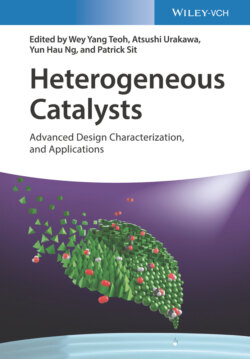Читать книгу Heterogeneous Catalysts - Группа авторов - Страница 80
6.3.1 Physical Methods
ОглавлениеPhysical synthesis of SACs can be realized through high vacuum physical deposition. For example, mass‐selected soft landing involves the use of a gas‐phase cluster as an ion source and a downstream mass spectrometer to mass‐select nanoclusters prior to their deposition onto a substrate (Figure 6.4) [18, 47]. In this case, metal clusters with precisely defined number of atoms can be produced and “soft‐landed” onto the surface of a desired substrate. This approach allows for independent control of cluster size and coverage and, in principle, can be used for any combination of cluster and flat support. Thus, this method can provide excellent model catalysts for fundamental research of active sites, metal–support interactions, and cluster size effects [21, 46–49]. Anderson and coworkers deposited Pd clusters (Pdn, n = 1, 2, 4, 7, 10, 16, 20, and 25) on clean, vacuum‐annealed rutile TiO2(110) to find out the correlation between the catalytic activity and the electronic structure of Pd clusters that varied with cluster size [48]. Supported size‐selected Pdn clusters were also tested in acetylene cyclotrimerization, and a single Pd atom adsorbed on MgO was found to be enough for the production of benzene at 300 K [21]. However, the disadvantage of this method is that the cost is high and the yield to desired catalysts is low, which makes it unsuitable for practical industrial applications. Moreover, this method is not suitable for making catalysts using high surface area or mesoporous supports, and it is difficult to achieve high metal loadings using this method. In all, this method is merely useful for making model catalysts for fundamental research.
Figure 6.4 Schematic drawing of size‐selected cluster deposition apparatus at Brookhaven National Laboratory.
Source: Vajda and White 2015 [46]. Reproduced with permission of American Chemical Society.
